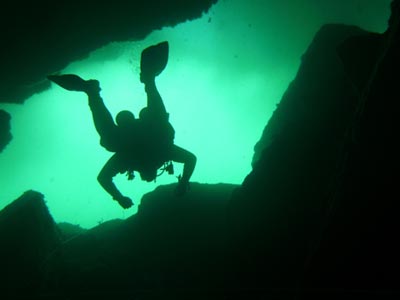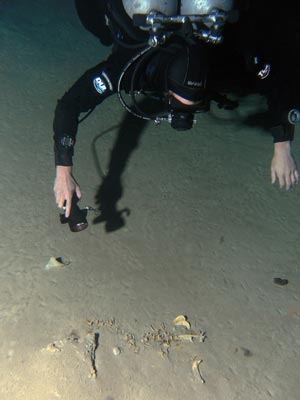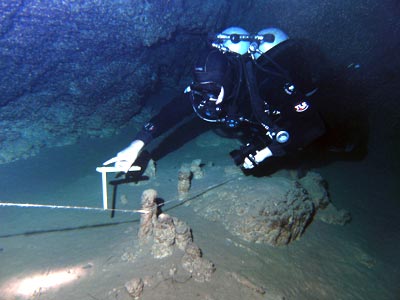 |
A diver descends into the Green Bay Cave System, Bermuda, at Cliff Pool Sinkhole. (Pete van Hengstum Photo). |
Deep water marine caves may be one of the Earth’s last unexplored frontiers.
Which makes Pete van Hengstum something of a scuba-diving cowboy. His exploration of underwater caves in Bermuda has uncovered new information about sea levels and climate change throughout Earth’s history.
‚ÄúUnderwater caves are interesting because only recently have advances in scuba diving technologies and protocols allowed scientists to safely explore and study these environments,‚ÄĚ says Dr. van Hengstum, 28, who has just completed his PhD in Earth Sciences at AVĺ„ņ÷≤Ņ.¬† ‚ÄúAlthough most researchers focus on the unique ecosystems and fauna in underwater caves, I suspected information about climate and sea levels was preserved in the underwater caves that no one really knew about before.‚ÄĚ
Spelunking is popular in Bermuda, where Dr. van Hengstum completed the fieldwork portion of his research. And no wonder: with a labyrinth of more than 150 limestone cave systems boasting impressive stalactites and stalagmites, Bermuda’s caves are fascinating and strange places to behold.
But whereas recreational spelunkers have their eyes on the beautiful formations on cave ceilings, Dr. van Hengstum is more interested in the muddy sediment on cave floors. He collected both surface samples and core samples of sediment from the submerged, underwater caves‚ÄĒwhich can be dangerous work. Hidden from the sun, the caves are completely dark and proper navigation is paramount. Scuba-diving researchers work in three-person teams and carry powerful flashlights, at least three each, to illuminate the murky depths.
 |
| Pete van Hengstum inspects a recent skeleton in the cave, which is resting on sediment filled with foraminifera. (Bruce Williams Photo) |
Contained in the mud are foraminifera, many thousands of species of single-celled organisms no bigger than a grain of sand. Resembling snails with shell-like chambers, they are found in all marine environments, from the tropics to the poles, from intertidal to the deepest ocean trenches, but species of foraminifera can be very particular about the environment in which they live. They have been studied all over the globe for more than 150 years, but Dr. van Hengstum is the first to describe the foraminifera ‚Äú that are happily living in unique underwater cave habitats.‚ÄĚ Captured in the fossil record, foraminifera provide evidence of past environments. More specifically, their shells reflect the changing temperature of ocean water, and shifting populations of foraminifera through time indicate how the cave environments have evolved in response to sea-level rise and fall over thousands of years.
The foraminifera and cave mud ‚Äúare the tools I use to answer questions about the natural environment,‚ÄĚ says Dr. van Hengstum.
A glacial process at the best of times, Dr. van Hengstum managed to complete his PhD in a relatively speedy 26 months. He‚Äôs since left AVĺ„ņ÷≤Ņ to start a Natural Sciences and Engineering Research Council of Canada (NSERC) Post-doctoral Fellowship at Woods Hole Oceanographic Institute in Woods Hole, Massachusetts.
Three main factors allowed him to finish his PhD in such a timely fashion. First, the people in Bermuda were exceptionally supportive of his research, especially his scuba-diving friends Bruce Williams and Gil Nolan, along with faculty at the Bermuda Aquarium, Museum, and Zoo and Bermuda Zoological Society. The anecdotal observations of local divers provide ‚Äúan invaluable resource that cannot be ignored when exploring underwater caves.‚ÄĚ
 |
Pete Van Hengstum measures sediment in the Green Bay Cave System, Bermuda. Note the white guide line that cave divers follow for underground navigation. (Gil Nolan Photo). |
Secondly, Dr. van Hengstum worked hard to secure funding for a project that had no external support when he began his doctorate. He arrived at AVĺ„ņ÷≤Ņ as an NSERC Alexander Graham Bell Canada Graduate Scholar and Honourary Killam Scholar and received grants from the Cave Research Foundation, the Sigma Xi Society, the Geologic Society of America, and the Bermuda Zoological Society to fund his initial scientific expeditions. He was also the inaugural recipient of the Johanna M. Resig Research Fellowship from the Cushman Foundation of Foraminiferal Research. This new $25,000 research grant is specifically designed for doctoral students completing innovative work with foraminifera, which allowed him to fund the lab work to compete his dissertation.
Finally, he adds he received invaluable support from AVĺ„ņ÷≤Ņ professors David Scott, John Gosse, and Martin Gibling.
‚ÄúA challenge of working with new science is that no one has ever done this before,‚ÄĚ says Dr. van Hengstum, a native of Port Colborne, Ont. who did his undergraduate and master‚Äôs degrees at McMaster University in Hamilton, Ont. ‚ÄúBut here at AVĺ„ņ÷≤Ņ, I was always welcome to debate and work out ideas with my mentors. I never felt alone here; the faculty members were very supportive and enthusiastic.‚ÄĚ
